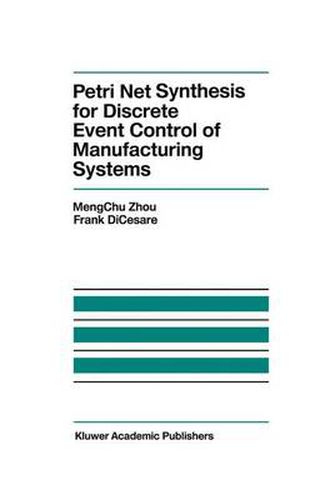Readings Newsletter
Become a Readings Member to make your shopping experience even easier.
Sign in or sign up for free!
You’re not far away from qualifying for FREE standard shipping within Australia
You’ve qualified for FREE standard shipping within Australia
The cart is loading…






This title is printed to order. This book may have been self-published. If so, we cannot guarantee the quality of the content. In the main most books will have gone through the editing process however some may not. We therefore suggest that you be aware of this before ordering this book. If in doubt check either the author or publisher’s details as we are unable to accept any returns unless they are faulty. Please contact us if you have any questions.
Petri Net Synthesis for Discrete Event Control of Manufacturing Systems develops two essential resource-sharing concepts: parallel and sequential mutual exclusions and theoretical results in Petri synthesis. A parallel mutual exclusion (PME) is defined to model a resource shared by independent distributed processes, and a sequential mutual exclusion is a sequential composition of PMEs, modeling a resource shared by sequentially-related processes. A hybrid synthesis methodology for Petri net models and controllers is proposed using top-down, modular, and bottom-up design ideas and the mutual exclusion theory. An aggregate Petri net model is refined by replacing places and/or transitions with basic design modules which are mathematically and graphically described. Petri net design methods are presented for such buffers as automatic storage and retrieval systems. Using the proposed method syntesized both a Petri net structure and feasible initial markings, guaranteeing that resulting Petri nets have desirable system properties such as freedom from deadlock and cyclic behaviour. A Petri net controller is extended to error recovery for automated manufacturing systems. The theory can guarantee that the desired system properties achieved by the original design will be preserved when the controller is augmented to deal with an error in the prescribed methods. Control code has been directly generated from Petri net definitions. The algorithm and implementation details are given for a flexible manufacturing system. Using the approach presented in Petri Net Synthesis for Discrete Event Control of Manufacturing Systems , engineers and research workers can develop their own discrete event control applications and experiments.
$9.00 standard shipping within Australia
FREE standard shipping within Australia for orders over $100.00
Express & International shipping calculated at checkout
This title is printed to order. This book may have been self-published. If so, we cannot guarantee the quality of the content. In the main most books will have gone through the editing process however some may not. We therefore suggest that you be aware of this before ordering this book. If in doubt check either the author or publisher’s details as we are unable to accept any returns unless they are faulty. Please contact us if you have any questions.
Petri Net Synthesis for Discrete Event Control of Manufacturing Systems develops two essential resource-sharing concepts: parallel and sequential mutual exclusions and theoretical results in Petri synthesis. A parallel mutual exclusion (PME) is defined to model a resource shared by independent distributed processes, and a sequential mutual exclusion is a sequential composition of PMEs, modeling a resource shared by sequentially-related processes. A hybrid synthesis methodology for Petri net models and controllers is proposed using top-down, modular, and bottom-up design ideas and the mutual exclusion theory. An aggregate Petri net model is refined by replacing places and/or transitions with basic design modules which are mathematically and graphically described. Petri net design methods are presented for such buffers as automatic storage and retrieval systems. Using the proposed method syntesized both a Petri net structure and feasible initial markings, guaranteeing that resulting Petri nets have desirable system properties such as freedom from deadlock and cyclic behaviour. A Petri net controller is extended to error recovery for automated manufacturing systems. The theory can guarantee that the desired system properties achieved by the original design will be preserved when the controller is augmented to deal with an error in the prescribed methods. Control code has been directly generated from Petri net definitions. The algorithm and implementation details are given for a flexible manufacturing system. Using the approach presented in Petri Net Synthesis for Discrete Event Control of Manufacturing Systems , engineers and research workers can develop their own discrete event control applications and experiments.